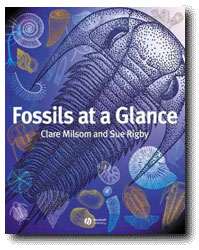Fossils at a Glance
by Clare Milsom and Sue Rigby
Blackwell Scientific Publishing;
(October 2003) 155 pages
ISBN: 0632060476

Fossils at a Glance
|
 |
Fossils at a Glance by Clare Milsom and Sue Rigby is a concise review of the various major fossil groups as well as several key topics in paleobiology. The book is reasonably priced at under $30.
The book covers the major invertebrate fossil groups (arranged logically from sponges to graptolites), as well as land plants, vertebrates, microfossils and trace fossils. In addition, Fossils at a Glance also contains chapters on fossil classification and evolution, and Precambrian and Phanerozoic paleobiologic trends. Chapters that concentrate on a particular fossil group are divided into several sections related to morphology, ecology, evolutionary history and also typically contain a section related to some specific aspect of the group under discussion (e.g., a section on Paleozoic reefs for the coral chapter, brachiopod community paleoecology, Carboniferous forests, sexual dimorphism for ammonoids, etc.). Each chapter is headed by a box with the major points covered by that chapter and ends with a glossary of terms. Those chapters that discuss particular fossil groups also contain drawings and descriptions of common or interesting taxa from that group.
The main strength and weakness of the book is the same: its concise style. The book covers a very wide range of topics, and I was pleasantly surprised by its inclusion of chapters on land plants and Precambrian life, two topics commonly overlooked in paleontology textbooks. I also quite liked that the authors included more than just descriptions of fossils, but also delved into how fossils are used in paleobiology. However, the book does suffer in some cases from its brief nature. While it is certainly difficult to please everyone when writing a textbook, certain key elements were missing from some chapters. For example, the chapter on sponges mentions the role of sponges in reef-building, and mentions that stromatoporoids were important reef builders in the Silurian and Devonian, but does not include a drawing or description of stromatoporoids anywhere (which I believe is important since students tend to confuse them easily with stromatolites). Another difficult aspect of the book is with respect to vocabulary terms. Many terms are used assuming the student already has previous knowledge of their definition, or are used in one place, and defined later in the book (e.g., deposit feeder). Each chapter does end with a glossary; however, none of the new terms in the text are boldfaced or otherwise noted, making if difficult for students to know which terms are important. The book also suffers in that it often assumes the student have previous knowledge of certain concepts, which may not be the case. For example, isotopes are brought up several times in the book, including the use of isotopes as climatic indicators (in the coral chapter), isotopic evidence of the first life on the planet (Precambrian life chapter), and isotopic excursions during the Cambrian (Phanerozoic life chapter), however isotopes are not explained or discussed in any great detail. A short 2 or 3 paragraph explanation of how isotopes are used in paleontology would benefit students greatly. A final criticism is with respect to the drawings and descriptions of examples of specific taxa from each fossil group at the end of each chapter. While this is a good idea, it would benefit from better organization. Drawings and descriptions of various examples are not clearly organized into higher taxonomic groups. Each example has the higher taxonomic group name under the drawing, a placement that may easily be overlooked by students. This could be especially confusing in the case of similar-looking taxa (e.g., gastropods and cephalopods).
While I do have some criticisms of the textbook, I feel that most of these criticisms can be overcome, and the book can be quite useful in a variety of situations. While Fossils at a Glance should not be substituted for a traditional paleontology textbook because of its concise nature, it would make a good reference book for a paleontology lab section (where the instructor writes the labs), or a good supplement to a paleobiology-based text that does not cover the major fossil groups (e.g., Raup and Sepkoski). In addition, this book would also serve as an excellent, reasonably priced supplement to a historical geology text, or in a program where paleontology is folded into another class (e.g., sedimentology and stratigraphy).